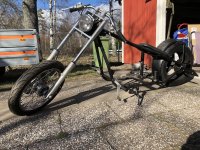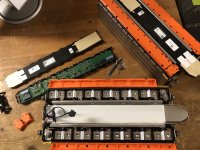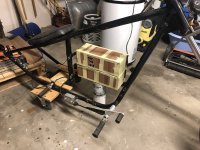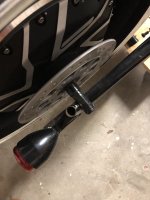Hi, I recently bought a rolling chassis of which I would like to DIY an electric motorcycle. My inspiration is the Sine Cycle motorcycle. I'd like to have decent "motorcycle acceleration" as well as freeway capability (not just i theory). Range is not this posts concern but I would like to get at least 50km.

I am currently quite clueless when it comes to which motor I should buy. But I think it should be the next purchase. I've been looking at the HPM10kW (which seems to be offered from anywhere between $680 to $2500 as a kit), ME1507, ME1003 (Good price, but brushed?), HPEVS AC20 (Looks good, but pricy), Agni 95R. But because I have a vertical bar just where to motor would go I have also looked at hub motors (only just under 200mm between rear fender and vertical bar). Particularly "QSMOTOR 12000W 17inch In-Wheel Hub Motor with 6.0×17 Rim" interests me. It requires a rear fork width of 230mm but my fork width is 255mm, but that shouldn't be a problem right (just put in a spacer and ask them for a longer axle)?
Right now I think the ideal motor would be a hub motor since I would not have to do any frame modification and entire Otto-motor space could be used for batteries, and the space under the seat could be used for the controller. Do anybody know the price, quality, spec-accuracy and life expectancy on QS Motors hub motors?
Talk me into a motor or out of a motor. Any good alternatives that I have missed?
EDIT: Changed subject

I am currently quite clueless when it comes to which motor I should buy. But I think it should be the next purchase. I've been looking at the HPM10kW (which seems to be offered from anywhere between $680 to $2500 as a kit), ME1507, ME1003 (Good price, but brushed?), HPEVS AC20 (Looks good, but pricy), Agni 95R. But because I have a vertical bar just where to motor would go I have also looked at hub motors (only just under 200mm between rear fender and vertical bar). Particularly "QSMOTOR 12000W 17inch In-Wheel Hub Motor with 6.0×17 Rim" interests me. It requires a rear fork width of 230mm but my fork width is 255mm, but that shouldn't be a problem right (just put in a spacer and ask them for a longer axle)?
Right now I think the ideal motor would be a hub motor since I would not have to do any frame modification and entire Otto-motor space could be used for batteries, and the space under the seat could be used for the controller. Do anybody know the price, quality, spec-accuracy and life expectancy on QS Motors hub motors?
Talk me into a motor or out of a motor. Any good alternatives that I have missed?
EDIT: Changed subject






